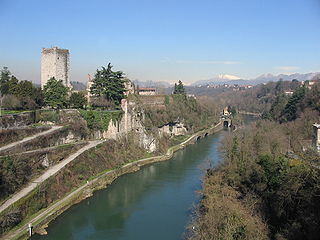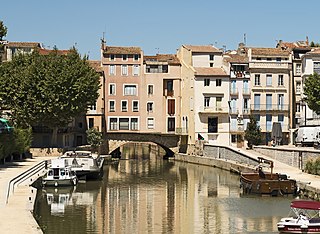
The ancient Romans were the first civilization to build large, permanent bridges. Early Roman bridges used techniques introduced by Etruscan immigrants, but the Romans improved those skills, developing and enhancing methods such as arches and keystones. There were three major types of Roman bridge: wooden, pontoon, and stone. Early Roman bridges were wooden, but by the 2nd century stone was being used. Stone bridges used the arch as their basic structure, and most used concrete, the first use of this material in bridge-building.

An arch bridge is a bridge with abutments at each end shaped as a curved arch. Arch bridges work by transferring the weight of the bridge and its loads partially into a horizontal thrust restrained by the abutments at either side. A viaduct may be made from a series of arches, although other more economical structures are typically used today.

The Pont Saint-Bénézet, also known as the Pont d'Avignon, was a medieval bridge across the Rhône in the town of Avignon, in southern France. Only four arches survive.

The Anji Bridge is the world's oldest open-spandrel segmental arch bridge of stone construction. Credited to the design of a craftsman named Li Chun, the bridge was constructed in the years 595–605 during the Sui dynasty (581–618). Located in the southern part of Hebei Province, it is the oldest standing bridge in China. It is considered one of the Four Treasures of Hebei.

The Pont Julien is a Roman stone arch bridge over the Calavon river, in the south-east of France, dating from 3 BC. The supporting columns are notable for openings to allow floodwater to pass through. It is located in the territory of the commune of Bonnieux, north of the village of the same name, and 8 km west of Apt. Originally, it was built on the Via Domitia, an important Roman road which connected Italy to the Roman territories in France. It was used for car traffic until 2005, when a replacement bridge was built to preserve it from wear and tear. It is still used as bike- and footpath. This amounts to approximately 2000 years of uninterrupted use.

The Pont-Saint-Martin is a Roman bridge in the Aosta Valley in Italy dating to the 1st century BC.

The Roman Bridge at Vaison-la-Romaine is a Roman bridge over the river Ouvèze in the southern French town of Vaison-la-Romaine. The bridge was built by the Romans in the 1st century AD, with a single arch spanning 17.20 m. It is still in use, and has survived severe flooding that swept away some more recent bridges.

The Alconétar Bridge, also known as Puente de Mantible, was a Roman segmental arch bridge in the Extremadura region, Spain. The ancient structure, which featured flattened arches with a span-to-rise ratio of 4–5:1, is one of the earliest of its kind. Due to its design, it is assumed that the bridge was erected in the early 2nd century AD by the emperors Trajan or Hadrian, possibly under the guidance of Apollodorus of Damascus, the most famous architect of the time.

The Trezzo sull'Adda Bridge or Trezzo Bridge was a medieval bridge at Trezzo sull'Adda in Lombardy, Italy, spanning the Adda river. Completed in 1377, the single-arch bridge held the record for the largest span for over four hundred years, until the beginnings of the Industrial Age, while it was not until the early 20th century that masonry bridges with larger openings were constructed.

The Pont del Diable, also known as Sant Bartomeu Bridge, is a medieval bridge crossing the river Llobregat and straddling the municipalities of Martorell and Castellbisbal in Catalonia, Spain. The bridge is restricted to pedestrians.

The Roman Bridge at Saint-Thibéry was a Roman bridge on the Via Domitia in southern France. The partly surviving structure crossed the river Hérault in Saint-Thibéry, 17 km (11 mi) east of Béziers.

The Pont des Marchands is a historic bridge in Narbonne, southern France. It serves as a foundation for a row of houses and shops underneath which the Canal de la Robine runs through the old town. Its segmental arch has a span of ca. 15 m. In Roman times the structure featured as many as six arches.
The Ponte del Gran Caso is a Roman bridge across the Torrente Gran Caso, 2 km south of Ascoli Piceno in central Italy.

The Pont de Pierre, meaning "Stone Bridge", is a Roman bridge in the Italian city of Aosta in the Aosta Valley. The bridge crossed the Buthier about 600 m (2,000 ft) from the eastern exit of the Roman colony Augusta Praetoria; in later times the torrente changed its course, leaving the ancient bridge today without water.
The Ponte San Lorenzo is a Roman bridge over the river Bacchiglione in Padua, Italy. Constructed between 47 and 30 BC, it is one of the very earliest segmental arched bridges in the world. It is also notable for the slenderness of its piers, unsurpassed in antiquity.

The Bridge near Limyra is a late Roman bridge in Lycia, in modern south-west Turkey, and one of the oldest segmented arch bridges in the world. Located near the ancient city of Limyra, it is the largest civil engineering structure of antiquity in the region, spanning the Alakır Çayı river over a length of 360 m (1,181.1 ft) on 26 segmental arches. These arches, with a span-to-rise ratio of 5.3:1, give the bridge an unusually flat profile, and were unsurpassed as an architectural achievement until the late Middle Ages. Today, the structure is largely buried by river sediments and surrounded by greenhouses. Despite its unique features, the bridge remains relatively unknown, and only in the 1970s did researchers from the Istanbul branch of the German Archaeological Institute carry out field examinations on the site.

The Macestus Bridge or Bridge of Sultançayır was a Roman bridge across the Macestus River at Balıkesir, in the northwestern part of modern-day Turkey. Its flattened arches, slender piers and the hollow chamber system documented the progress made in late antique bridge building. A first cursory investigation of the 234 m long structure was conducted in the early 20th century, but since then its existence has been largely neglected by scholars. Current photos from 2009 show that the bridge has collapsed in the meantime.
Émiland Marie Gauthey was a French mathematician, civil engineer and architect. As an engineer for the Estates of Burgundy, he was the creator of a great deal of the region's civil infrastructure, such as the Canal du Centre between Digoin and Chalon-sur-Saône (1784–1793), bridges including those at Navilly (1782–1790) and Gueugnon (1784–1787), and buildings such as the Eglise Saint-Pierre-et-Saint-Paul at Givry and the theatre at Chalon-sur-Saône.

A segmental arch is a type of arch with a circular arc of less than 180 degrees. It is sometimes also called a scheme arch.


















